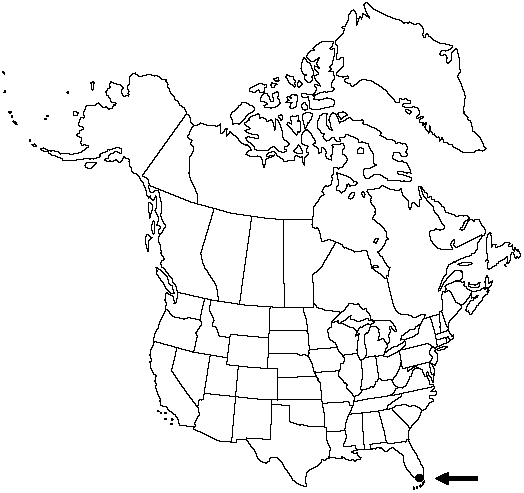Asplenium ×biscayneanum
Fern Bull. 12: 45. 1904.
Roots proliferous. Stems erect, not branched; scales blackish throughout, linear-deltate, sparse, 1–1.3 × 0.1–2.4 mm, margins entire. Leaves nearly monomorphic. Petiole green, becoming blackish in older leaves, 1–5 (–12) cm, 1/8–1/3 length of blade; indument of black, narrowly lanceolate scales. Blade dull, linear, 2-pinnate, (4–) 12–22 × 1–3.5 cm, papery, glabrous; base slightly tapered; apex narrowing gradually, not rooting. Rachis mostly blackish, green distally and in juvenile leaves, shiny, sparsely scaly. Pinnae in 9–20 pairs, oblong, 0.5–2 × 0.4–1.3 cm; apex blunt to truncate. Pinnules of 1–2 segments; segments linear-oblong, 3–6 × 1–3 mm; margins dentate; apex notched, pointed, rounded, or blunt. Veins free, evident. Sori 1–2 per segment, on both basiscopic and acroscopic sides. Spores abortive. 2n = ca. 180.
Habitat: Hammocks, on limestone rock faces
Elevation: 0–20 m
Distribution

Fla.
Discussion
Asplenium × biscayneanum is the hybrid of A. trichomanes-dentatum and A. verecundum, with which it occurs. This peculiar spleenwort may most readily be separated from A. trichomanes-dentatum by its deeply cut pinnae, and from A. verecundum by being only 2-pinnate and having long petioles. Chromosome pairing in A. × biscayneanum is irregular. Judging from herbarium collections, it shows considerable hybrid vigor. All the collections are from Dade County, Florida, where it may now be extirpated.
Selected References
None.
Lower Taxa
"/8lengthofblade" is not declared as a valid unit of measurement for this property.